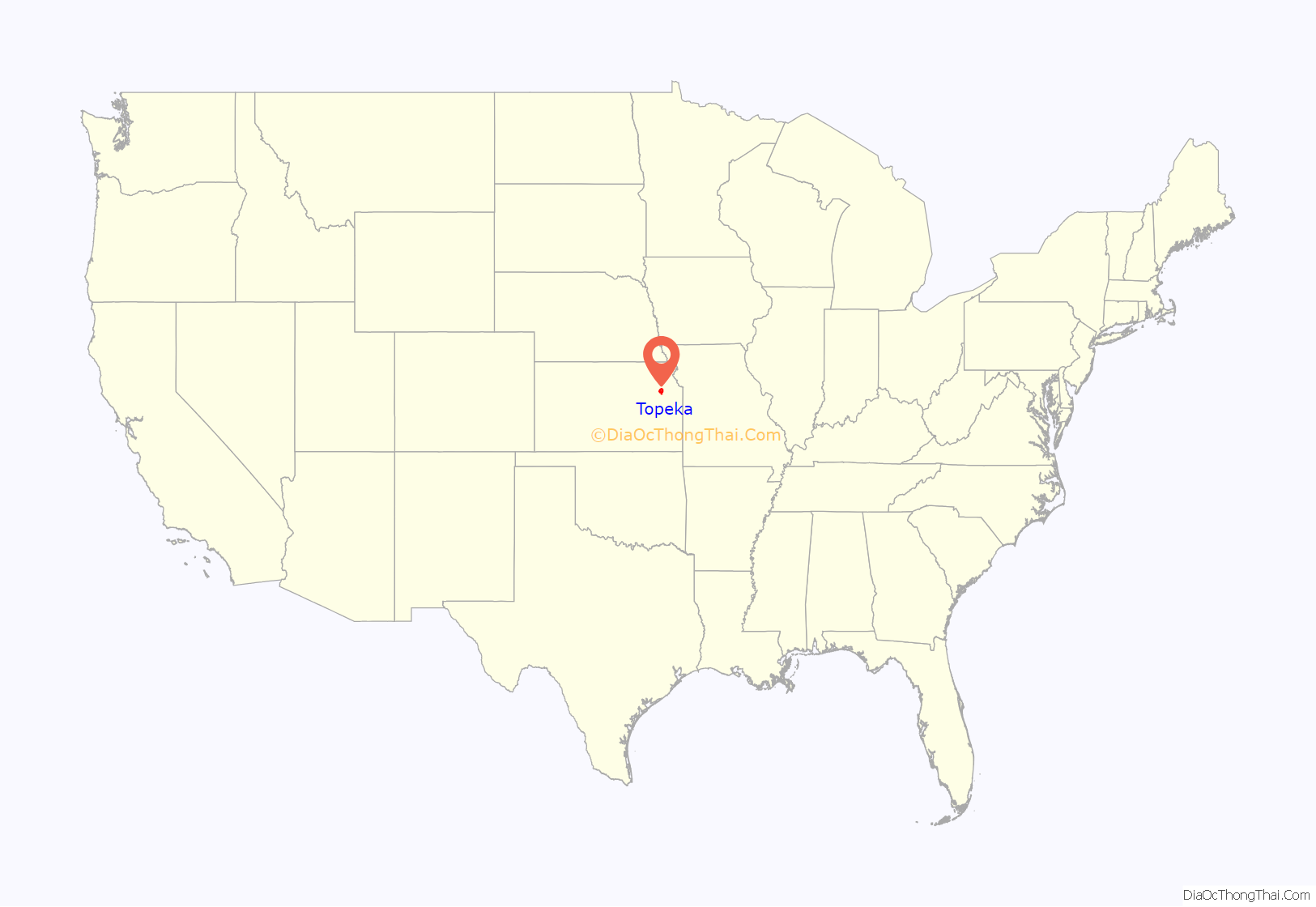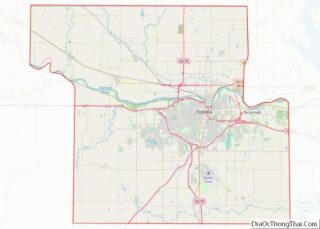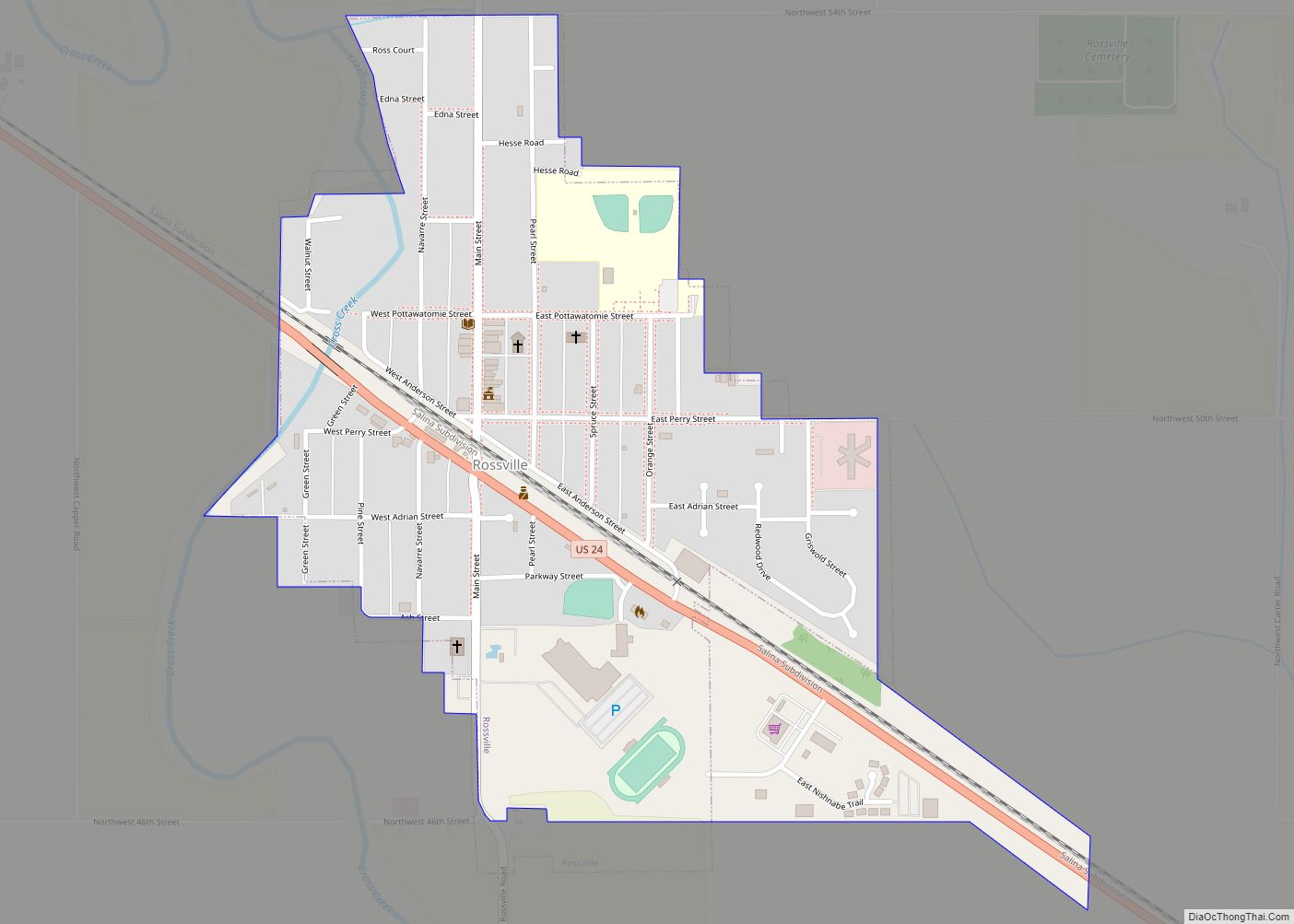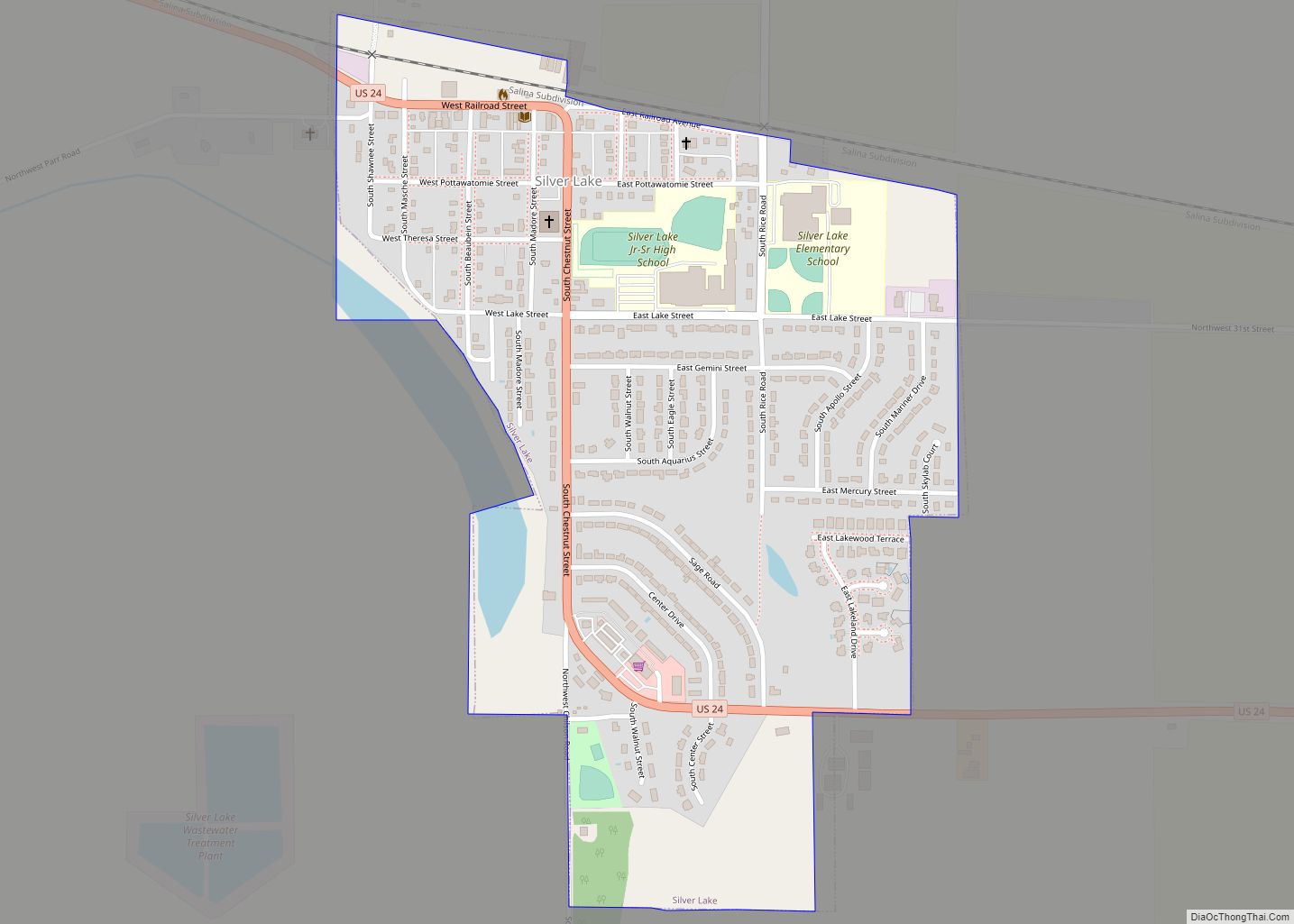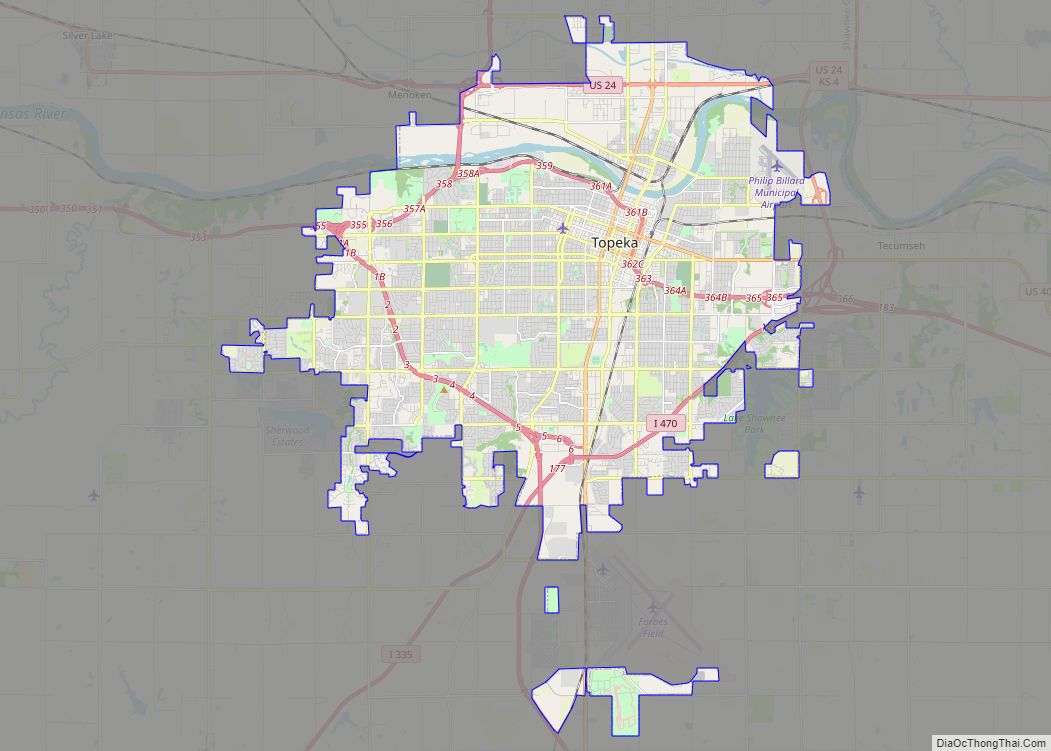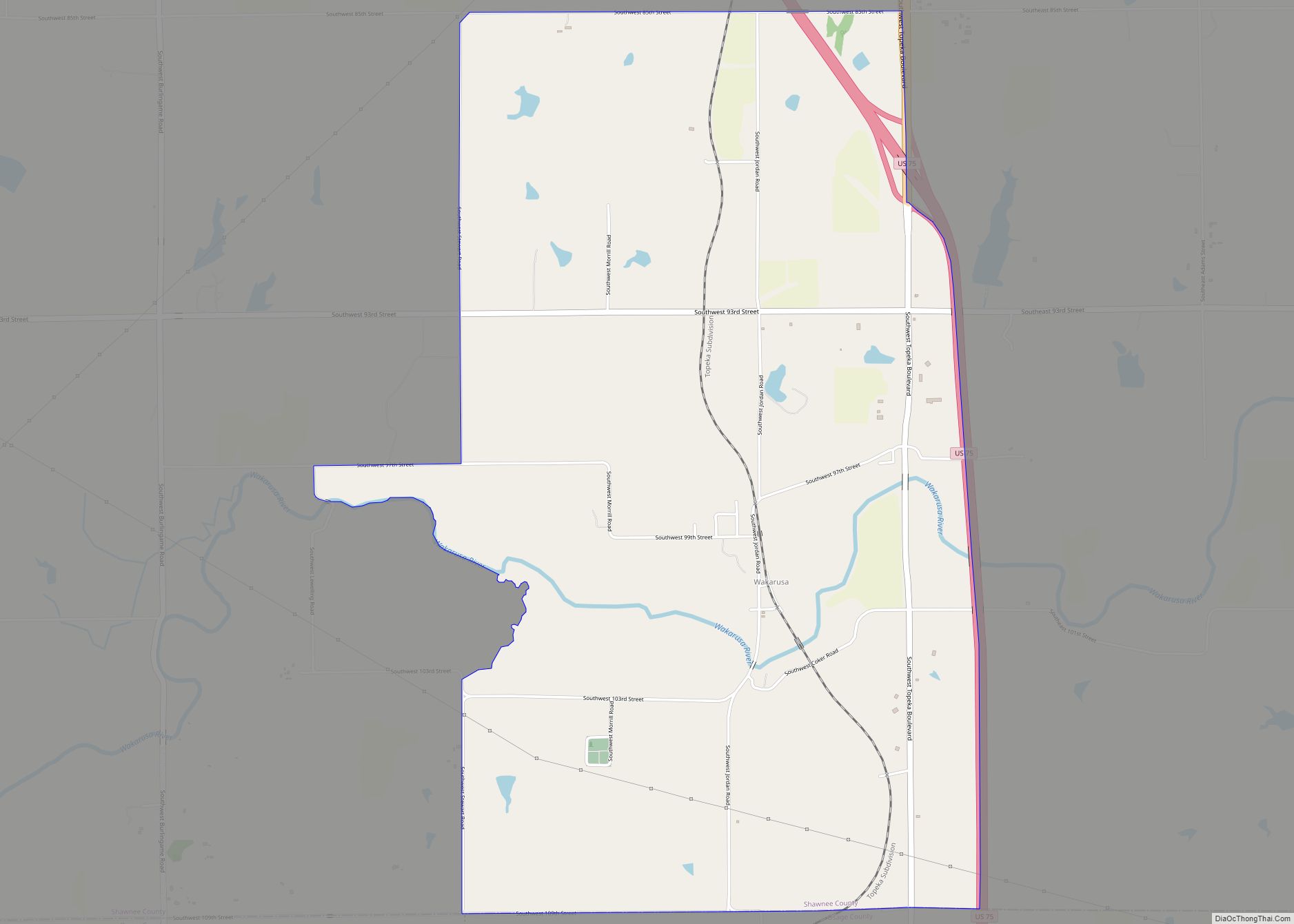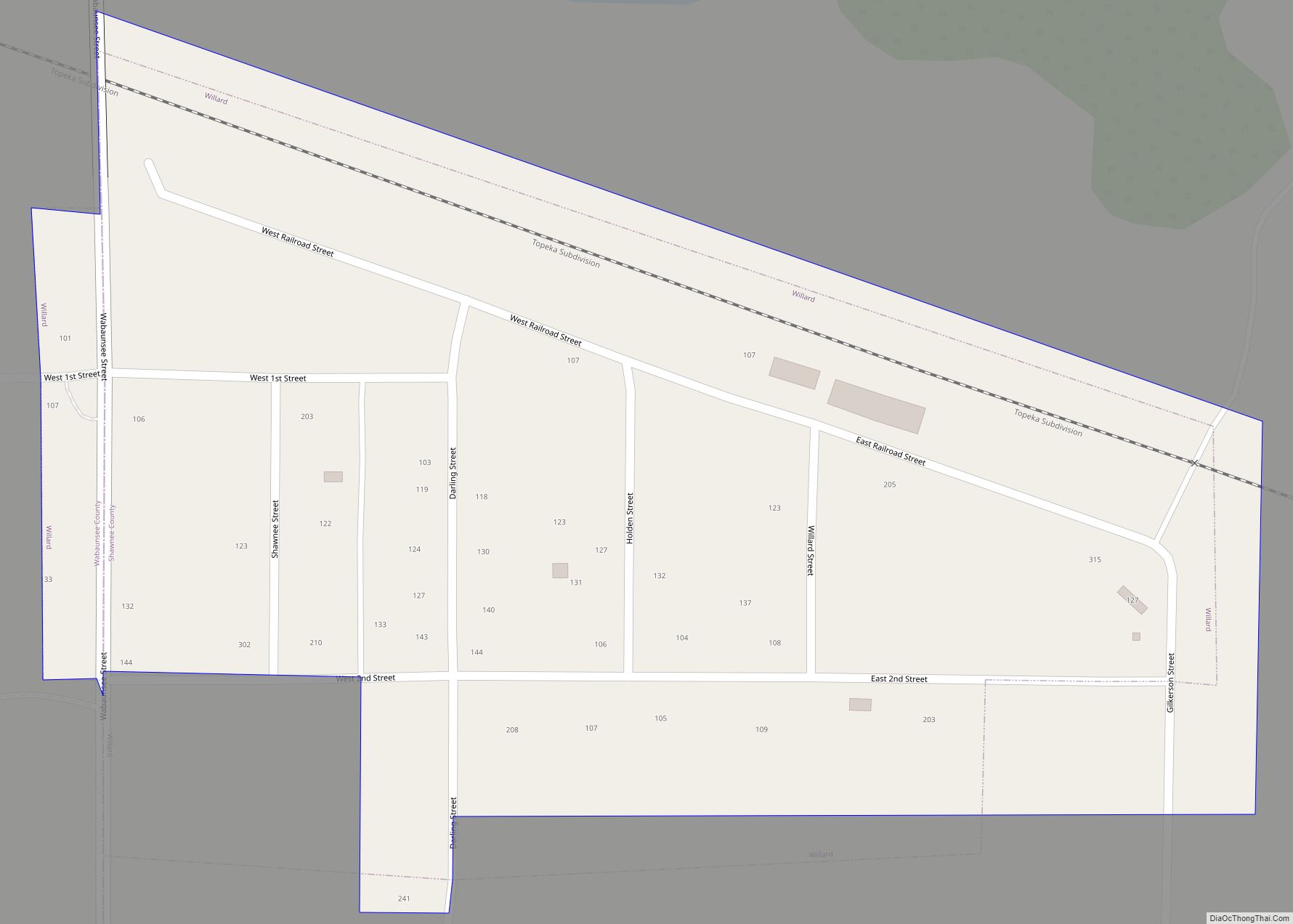Topeka (/təˈpiːkə/ tə-PEE-kə; Kansa: tó ppí kʼé; Iowa-Oto: Dópikˀe or Dópiúkˀe) is the capital city of the U.S. state of Kansas and the seat of Shawnee County. It is along the Kansas River in the central part of Shawnee County, in northeast Kansas, in the Central United States. As of the 2020 census, the population of the city was 126,587. The Topeka metropolitan statistical area, which includes Shawnee, Jackson, Jefferson, Osage, and Wabaunsee Counties, had a population of 233,870 in the 2010 census.
The name “Topeka” is a Kansa-Osage word that means “place where we dig potatoes”, or “a good place to dig potatoes”. As a placename, Topeka was first recorded in 1826 as the Kansa name for what is now called the Kansas River. Topeka’s founders chose the name in 1855 because it “was novel, of Indian origin, and euphonious of sound.” Mixed-blood Kansa Native American, Joseph James, called Jojim, is credited with suggesting Topeka’s name. The city, laid out in 1854, was one of the Free-State towns founded by Eastern antislavery men immediately after the passage of the Kansas–Nebraska Bill. In 1857, Topeka was chartered as a city.
The city is well known for the landmark U.S. Supreme Court case Brown v. Board of Education of Topeka, which overturned Plessy vs. Ferguson and declared racial segregation in public schools to be unconstitutional.
| Name: | Topeka city |
|---|---|
| LSAD Code: | 25 |
| LSAD Description: | city (suffix) |
| State: | Kansas |
| County: | Shawnee County |
| Founded: | 1854 |
| Incorporated: | 1857 |
| Elevation: | 948 ft (289 m) |
| Land Area: | 61.44 sq mi (159.14 km²) |
| Water Area: | 1.31 sq mi (3.39 km²) |
| Population Density: | 2,000/sq mi (780/km²) |
| Area code: | 785 |
| FIPS code: | 2071000 |
| Website: | topeka.org |
Online Interactive Map
Click on ![]() to view map in "full screen" mode.
to view map in "full screen" mode.
Topeka location map. Where is Topeka city?
History
Early history
For many millennia, Native Americans inhabited the Great Plains of North America. From the 16th to the mid-18th centuries, the Kingdom of France laid claim to large parts of North America. In 1762, late in the French and Indian War, France secretly ceded Louisiana west of the Mississippi River to Spain in the Treaty of Fontainebleau. In 1800, Spain returned Louisiana to France. In 1803, the United States purchased the territory, which included most of the land of modern Kansas, from France for $15 million.
19th century
In the 1840s, wagon trains made their way west from Independence, Missouri, on a journey of 2,000 miles (3,000 km), following what came to be known as the Oregon Trail. About 60 miles (97 km) west of Kansas City, Missouri, three half-Kansas Indian sisters married to the French-Canadian Pappan brothers established a ferry service allowing travelers to cross the Kansas River at what is now Topeka. During the 1840s and into the 1850s, travelers could reliably find a way across the river, but little else was in the area.
In the early 1850s, traffic along the Oregon Trail was supplemented by trade on a new military road stretching from Fort Leavenworth through Topeka to the newly established Fort Riley. In 1854, after completion of the first cabin, nine men established the Topeka Town Association. The group included Cyrus K. Holliday, an “idea man”, who became mayor of Topeka and founder of the Atchison, Topeka & Santa Fe Railroad. Soon, steamboats were regularly docking at the Topeka landing, depositing meat, lumber, and flour and returning eastward with potatoes, corn, and wheat. By the late 1860s, Topeka had become a commercial hub that offered many Victorian era comforts.
Topeka was a bastion for the free-state movement during the problems in Kansas Territory between abolitionist and proslavery settlers (the latter of whom controlled the legal government based out of Lecompton). After southern forces barricaded Topeka in 1856, Topeka’s leaders took actions to defend the free-state town from invasion. A militia was organized and stone fortifications were built on Quincy Street. The fortifications seemed to consist of low-lying earthwork levies strengthened by the presence of at least one cannon. The militia manned the fortifications until at least September 1856, when the siege around the town was lifted.
After a decade of abolitionist and proslavery conflict that gave the territory the nickname Bleeding Kansas, Kansas was admitted to the Union in 1861 as the 34th state. Topeka was chosen as the capital, with Dr. Charles Robinson as the first governor. In 1862, Cyrus K. Holliday donated a tract of land to the state for the construction of a state capitol. Construction of the Kansas State Capitol began in 1866. About 37 years were needed to build the capitol, first the east wing, and then the west wing, and finally the central building, using Kansas limestone. In fall 1864, a stockade fort, later named Fort Simple, was built in the intersection of 6th and Kansas Avenues to protect Topeka, should Confederate forces then in Missouri decide to attack the city. It was abandoned by April 1865 and demolished in April 1867.
State officers first used the state capitol in 1869, moving from Constitution Hall, what is now 427-429 S. Kansas Avenue. Besides being used as the Kansas statehouse from 1863 to 1869, Constitution Hall is the site where antislavery settlers convened in 1855 to write the first of four state constitutions, making it the “Free State Capitol”. The National Park Service recognizes Constitution Hall in Topeka as headquarters in the operation of the Lane Trail to Freedom on the Underground Railroad, the chief slave escape passage and free-trade road.
Although the drought of 1860 and the ensuing period of the Civil War slowed the growth of Topeka and the state, Topeka kept pace with the revival and period of growth Kansas enjoyed from the close of the war in 1865 until 1870. In the 1870s, many former slaves, known as Exodusters, settled on the east side of Lincoln Street between Munson and 12th Streets. The area was known as Tennessee Town because so many of them were from the Volunteer State. Dr. Charles Sheldon, pastor of the Central Congregational Church, organized the first African American kindergarten west of the Mississippi in 1893.
Lincoln College, now Washburn University, was established in 1865 in Topeka by a charter issued by the State of Kansas and the General Association of Congregational Ministers and Churches of Kansas. In 1869, the railway started moving westward from Topeka, where general offices and machine shops of the Atchison, Topeka & Santa Fe Railroad system were established in 1878.
During the late 1880s, Topeka passed through a boom period that ended in disaster. Vast speculation on town lots occurred. The 1889 bubble burst, and many investors were ruined. Topeka, however, doubled in population during the period, and was able to weather the depressions of the 1890s.
Early in the 20th century, another kind of boom, this time the automobile industry, took off, and numerous pioneering companies appeared and disappeared. Topeka was not left out. The Smith Automobile Company was founded there in 1902, lasting until 1912.
20th century
Home to the first African-American kindergarten west of the Mississippi River, Topeka was the home of Oliver Brown, the named plaintiff in Brown v. Board of Education, which was the case responsible for eliminating the standard of “separate but equal”, and requiring racial integration in American public schools. In 1960, the Census Bureau reported Topeka’s population as 91.8% White and 7.7% Black.
At the time the suit was filed, only the elementary schools were segregated in Topeka, and Topeka High School had been fully integrated since its inception in 1871. Furthermore, Topeka High School was the only public high school in the city of Topeka. Other rural high schools existed, such as Washburn Rural High School—created in 1918—and Seaman High School—created in 1920. Highland Park High School became part of the Topeka school system in 1959 along with the opening of Topeka West High School in 1961. A Catholic high school —Assumption High School, later renamed Capitol Catholic High School, then in 1939 again renamed, to Hayden High School after its founder, Father Francis Hayden — also served the city beginning in 1911.
Monroe Elementary, a segregated school that figured in the historic Brown v. Board of Education decision, through the efforts of the Brown Foundation working with the Kansas Congressional delegation place in the early 1990s, is now Brown v. Board of Education National Historic Site. The Brown Foundation is largely responsible for the content of the interpretive exhibits at the historic site. The National Historic Site was opened by President George W. Bush on May 17, 2004.
Topeka has struggled with the burden of racial discrimination even after Brown. New lawsuits attempted unsuccessfully to force suburban school districts that ring the city to participate in racial integration with the inner-city district. In the late 1980s, a group of citizens calling themselves the Task Force to Overcome Racism in Topeka formed to address the problem in a more organized way.
On June 8, 1966, Topeka was struck by a tornado rated F5 on the Fujita scale. It started on the southwest side of town, moving northeast, passing over a local landmark named Burnett’s Mound. According to a local Indian legend, this mound was thought to protect the city from tornadoes if left undisturbed. A few years prior to the tornado strike, development began near the mound, including a water tank constructed near the top of the mound against the warnings of local Native Americans. The tornado went on to rip through the city, hitting the downtown area and Washburn University. Total repair cost was put at $100 million, making it, at the time, one of the most costly tornadoes in American history. Even to this day, with inflation factored in, the Topeka tornado stands as one of the most costly on record. It also helped bring to prominence future CBS and A&E broadcaster Bill Kurtis, who became well known for his televised admonition to “…take cover, for God’s sake, take cover!” on WIBW-TV during the tornado. (The city is home of a National Weather Service Forecast Office that serves 23 counties in north-central, northeast, and east-central Kansas).
Topeka recovered from the 1966 tornado and has sustained steady economic growth. Washburn University, which lost several historic buildings, received financial support from the community and alumni to rebuild many school facilities. Today, university facilities offer more than one million square feet of modern academic and support space.
In 1974, Forbes Air Force Base closed and more than 10,000 people left Topeka, influencing the city’s growth patterns for years to come. During the 1980s, Topeka citizens voted to build a new airport and convention center and to change the form of city government. West Ridge Mall opened in 1988, replacing the White Lakes Mall, which opened in 1964.
In 1989, Topeka became a motorsports mecca with the opening of Heartland Park Topeka. The Topeka Performing Arts Center opened in 1991. In the early 1990s, the city experienced business growth with Reser’s Fine Foods locating in Topeka and expansions for Santa Fe and Hill’s Pet Nutrition.
During the 1990s, voters approved bond issues for public school improvements, including magnet schools, technology, air conditioning, classrooms, and a sports complex. Voters also approved a quarter-cent sales tax for a new law-enforcement center, and in 1996, approved an extension of the sales tax for the East Topeka Interchange connecting the Oakland Expressway, K-4, I-70, and the Kansas Turnpike. During the 1990s, Shawnee County voters approved tax measures to expand the Topeka and Shawnee County Public Library. The Kansas Legislature and governor also approved legislation to replace the majority of the property tax supporting Washburn University with a countywide sales tax.
21st century
In 2000, the citizens again voted to extend the quarter-cent sales tax, this time for the economic development of Topeka and Shawnee County. In August, 2004, Shawnee County citizens voted to repeal the 2000 quarter-cent sales tax and replace it with a 12-year, half-cent sales tax designated for economic development, roads, and bridges. Each year, the sales tax provides $5 million designated for business development and job creation incentives, and $9 million for roads and bridges. Planning is under way to continue to redevelop areas along the Kansas River, which runs west to east through Topeka. In the Kansas River Corridor through the center of town, downtown Topeka has experienced apartment and condominium loft development, and façade and streetscape improvements.
On March 1, 2010, Topeka Mayor Bill Bunten issued a proclamation calling for Topeka to be known for the month of March as “Google, Kansas, the capital city of fiber optics.” The name change came from Ryan Gigous, who wanted to “re-brand” the city with a simple gesture. This was to help “support continuing efforts to bring Google’s fiber experiment” to Topeka, though it was not a legal name change. Lawyers advised the city council and mayor against an official name change. Google jokingly announced it would change its name to Topeka to “honor that moving gesture” on April 1, 2010 (April Fools’ Day) and changed its home page to say Topeka. In its official blog, Google announced this change thus affected all of its services as well as its culture, e.g. “Googlers” to “Topekans”, “Project Virgle” to “Project Vireka”, and proper usage of “Topeka” as an adjective and not a verb, to avoid the trademark becoming genericized.
Topeka Road Map
Topeka city Satellite Map
Geography
Topeka is at 39°03′N 95°41′W / 39.050°N 95.683°W / 39.050; -95.683, in north east Kansas at the intersection of I-70 and U.S. Highway 75. It is the origin of I-335 which is a portion of the Kansas Turnpike running from Topeka to Emporia, Kansas. Topeka is also on U.S. Highway 24 (about 50 miles [80 km] east of Manhattan, Kansas) and U.S. Highway 40 (about 30 miles [48 km] west of Lawrence, Kansas). US 40 is coincident with I-70 west from Topeka. According to the United States Census Bureau, the city has a total area of 61.47 sq mi (159.21 km), of which 1.30 sq mi (3.37 km) are covered by water.
Climate
In 2007, Forbes named Topeka as one of the leading U.S. cities in terms of having the greatest variations in temperature, precipitation, and wind. Topeka has a humid continental climate (Köppen climate classification Dfa), with hot, somewhat humid summers and cool to cold, fairly dry winters, and is in USDA plant hardiness zone 6a. Over the course of a year, the monthly daily average temperature ranges from 30.2 °F (−1.0 °C) in January to 79.8 °F (26.6 °C) in July. The maximum temperature reaches 90 °F (32 °C) an average of 49.6 afternoons per year and reaches 100 °F (38 °C) an average of 6.0 afternoons per year. The minimum temperature falls below 0 °F (−18 °C) an average of 2.7 mornings per year, and 21.7 afternoons per year stay below freezing. The average window for freezing temperatures is October 15 through April 17.
The area receives about 36.53 inches (928 mm) of precipitation during a typical year, with the largest share being received in May and June—the April through June period averages 32.8 days of measurable precipitation. Generally, the spring and summer have the most rainfall, with autumn and winter being fairly dry. During a typical year, the total amount of precipitation may vary from 25 to 47 inches (640 to 1,190 mm). Much of the rainfall is delivered by thunderstorms. These can be severe, producing frequent lightning, large hail, and sometimes tornadoes. An average of 100 days of measurable precipitation occur per year. Winter snowfall is light, as is the case in most of the state, as a result of the dry, sunny weather patterns that dominate Kansas winters, which do not allow for sufficient moisture for significant snowfall. Winter snowfall averages 17.1 in (43 cm). Measurable (≥0.1 in or 0.25 cm) snowfall occurs an average of 12 days per year, with at least 1.0 in (2.5 cm) of snow being received on five of those days. Snow depth of at least an inch occurs an average of 17.7 days per year.
See also
Map of Kansas State and its subdivision:- Allen
- Anderson
- Atchison
- Barber
- Barton
- Bourbon
- Brown
- Butler
- Chase
- Chautauqua
- Cherokee
- Cheyenne
- Clark
- Clay
- Cloud
- Coffey
- Comanche
- Cowley
- Crawford
- Decatur
- Dickinson
- Doniphan
- Douglas
- Edwards
- Elk
- Ellis
- Ellsworth
- Finney
- Ford
- Franklin
- Geary
- Gove
- Graham
- Grant
- Gray
- Greeley
- Greenwood
- Hamilton
- Harper
- Harvey
- Haskell
- Hodgeman
- Jackson
- Jefferson
- Jewell
- Johnson
- Kearny
- Kingman
- Kiowa
- Labette
- Lane
- Leavenworth
- Lincoln
- Linn
- Logan
- Lyon
- Marion
- Marshall
- McPherson
- Meade
- Miami
- Mitchell
- Montgomery
- Morris
- Morton
- Nemaha
- Neosho
- Ness
- Norton
- Osage
- Osborne
- Ottawa
- Pawnee
- Phillips
- Pottawatomie
- Pratt
- Rawlins
- Reno
- Republic
- Rice
- Riley
- Rooks
- Rush
- Russell
- Saline
- Scott
- Sedgwick
- Seward
- Shawnee
- Sheridan
- Sherman
- Smith
- Stafford
- Stanton
- Stevens
- Sumner
- Thomas
- Trego
- Wabaunsee
- Wallace
- Washington
- Wichita
- Wilson
- Woodson
- Wyandotte
- Alabama
- Alaska
- Arizona
- Arkansas
- California
- Colorado
- Connecticut
- Delaware
- District of Columbia
- Florida
- Georgia
- Hawaii
- Idaho
- Illinois
- Indiana
- Iowa
- Kansas
- Kentucky
- Louisiana
- Maine
- Maryland
- Massachusetts
- Michigan
- Minnesota
- Mississippi
- Missouri
- Montana
- Nebraska
- Nevada
- New Hampshire
- New Jersey
- New Mexico
- New York
- North Carolina
- North Dakota
- Ohio
- Oklahoma
- Oregon
- Pennsylvania
- Rhode Island
- South Carolina
- South Dakota
- Tennessee
- Texas
- Utah
- Vermont
- Virginia
- Washington
- West Virginia
- Wisconsin
- Wyoming
